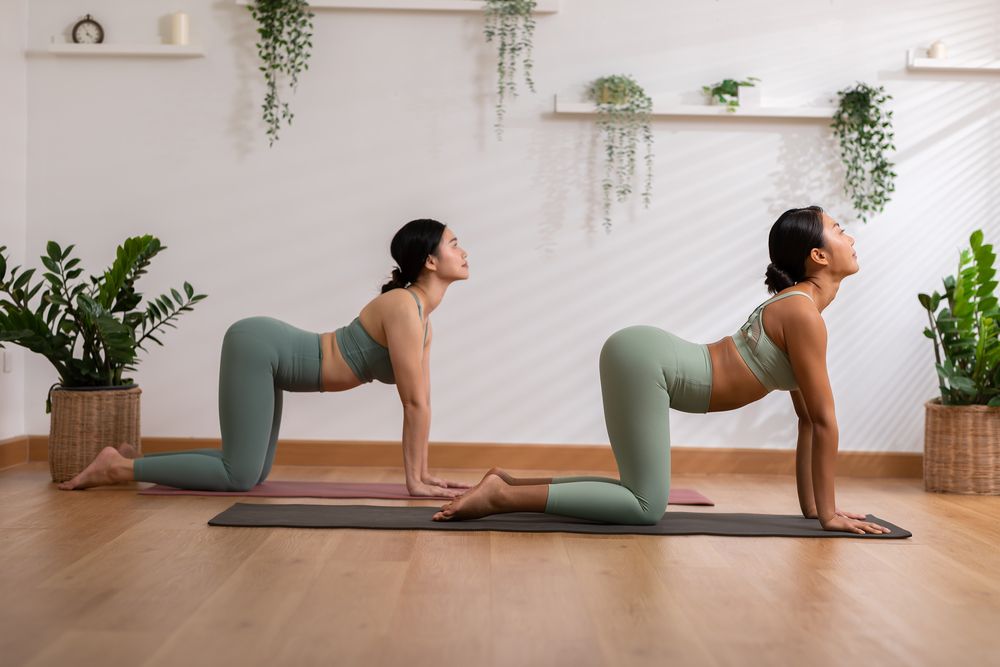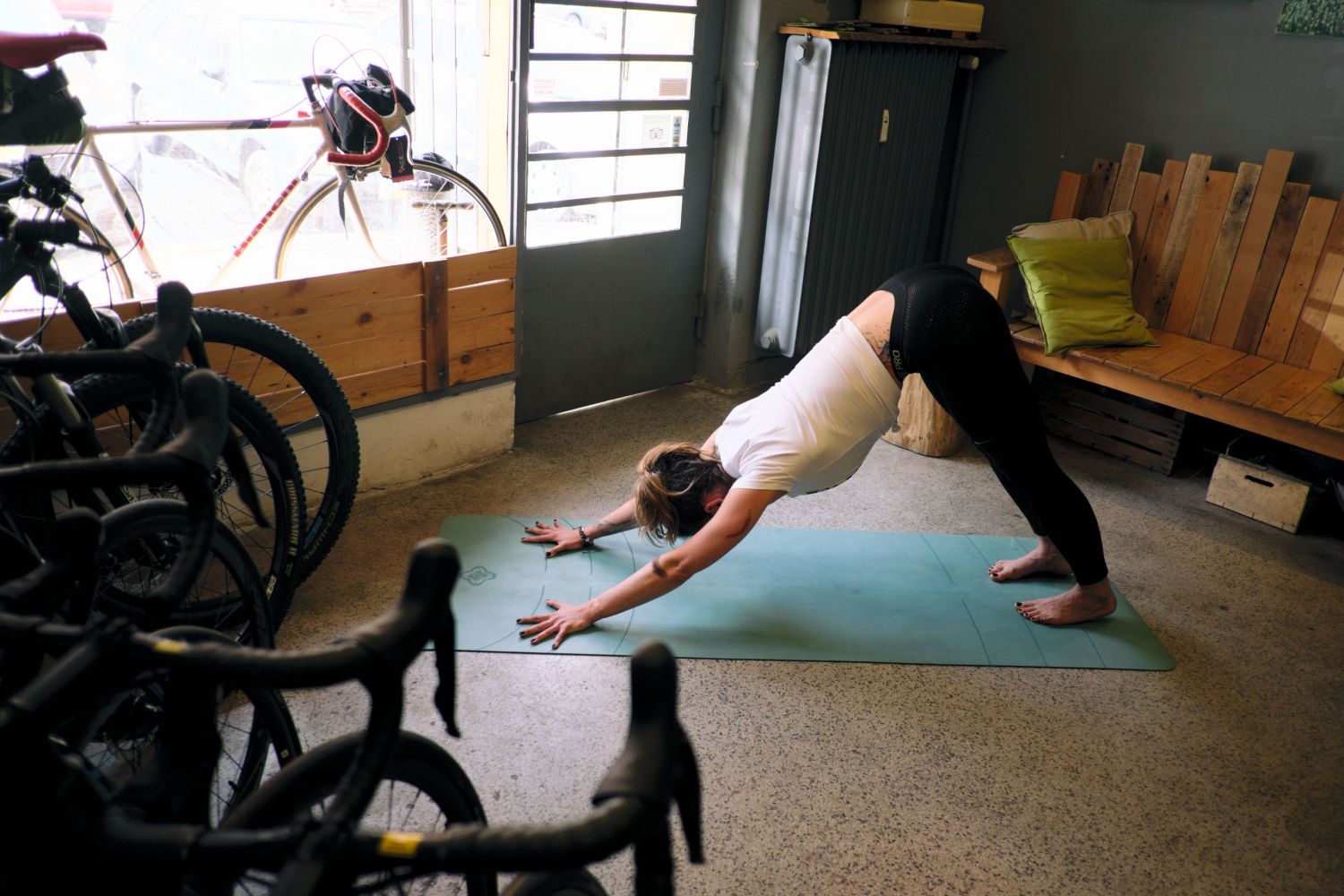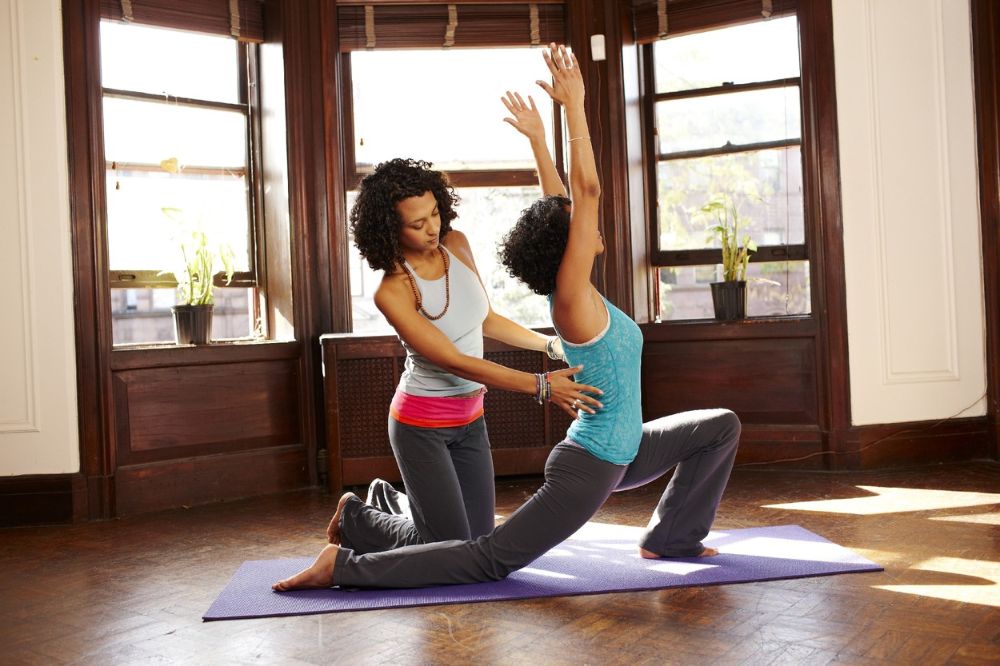Here’s a little secret, though—those characteristics have just as much potential to help you improve your performance on the bike. In addition, they might even be able to help improve your overall quality of life. So, if that sounds like something you’re interested in, please, read on.
I’ve been running, riding bikes, dancing, and playing sports since I was a kid. I also attended a few yoga classes sporadically throughout my early 20s. Although I enjoyed the lessons that I managed to make it to, it was only as I began to reflect on the damage that some of my other activities were doing to my body—in addition to the role that fitness plays in mental health— that I began to take yoga seriously.
Having recently completed a comprehensive Vinyasa yoga teacher certification, I am more convinced than ever of yoga’s benefits, especially for those of us who love to ride. With that in mind, let’s dig into how yoga can benefit you as a cyclist and a few accessible yoga postures that you can get started with today!
Yoga and cycling have more in common than you think
If you think of yoga as a primarily static practice, it is probably because you haven’t tried it. Many types of yoga involve what we call ‘flow’ or moving meditation. You transition seamlessly from one posture to another, using your breath as the bridge that links everything together and creates a cohesive mind-body experience. Not unlike what happens when you get into the zone while riding your bike, you benefit most from your practice when you can maintain fluid breathing and a steady heart rate, keep a handle on what’s going on mentally, and hold an ongoing balance of effort.
Yoga alleviates pain now and protects your future mobility
For all the benefits that cycling offers our bodies, we have to admit that it also confines us to limited movement on a single plan of motion. As you’re likely aware, this repetitive motion can cause significant tightness in the hip flexors, quads, and calves. It can also result in adaptive muscle shortening, and the position we assume on the bike tends to tighten up the back and shoulders.
Yoga is the perfect antidote to lengthen everything back out, relieve tightness, alleviate pain and prevent injuries down the road. We might be focused on one thing while riding but having a limited range of motion means that you’re more likely to rely on a smaller group of muscles to do everything. This tendency towards overuse and adaptively shortened muscles is how injuries sneak up on us years down the road.
Yoga isn’t just about stretching; get ready to gain some serious strength
Although yoga is undoubtedly an excellent tool to improve your range of motion, it isn’t all about stretching and flexibility. If you’ve ever taken a vinyasa flow class before, you’ll know that yoga can be a dynamic and heat-building activity. It uses isometric and bodyweight exercises to challenge and improve functional strength. Many yoga asanas (postures) require balance and control. This means that a bunch of smaller muscles that we rarely use to fire up and help us maintain a stable foundation. As such, yoga can also improve general stability on the bike while building the muscles needed to produce more power with every pedal stroke.
Breathing and focus techniques give you an edge while riding
Most yoga-curious athletes come to class with the notion of doing right by their joints and muscles. However, the multitude of additional benefits start to reveal themselves for those who stick around. Since breathing is so central to the practice, you’ll soon find that regular posture practice translates to a more even breathing cadence throughout all of your athletic pursuits.
Regularly taking the time to practice conscious breathing techniques like those used in yoga can significantly improve your circumferential breathing and train your respiratory muscles to take in more air. Focusing on this aspect of the practice also has an overall calming effect and taps into your ability to summon mental focus and keep a clear head when things get challenging (on or off the bike).
5 great postures for cyclists
If you’re new to yoga, it is essential to take things slow and build a strong foundation for your future practice. Your initial focus should be on proper alignment, knowing that you can refine form and breath as you move deeper into the poses. While you’re moving through the posture, be aware of the quality of your breathing, spinal alignment, and muscle awareness—qualities that will all positively impact your pedal stroke.
Cat-cow pose (Bitilasana Marjaryasana)
Stiffness and back pain is a reality for most cyclists, and that’s why the spinal mobility aspect of yoga is so beneficial. Moving through a cat-cow pose gently stretches and releases the spine, eliminating tension across the shoulders and lower back. As in most yoga poses, you need to maintain an active engagement in the core to keep your spine straight—meaning you’re also helping to tone the muscles that wrap around the centre of your body.

Method:
• Begin on all fours with your hands placed firmly on the mat, shoulder-width apart. Your knees should be directly below your hips.
• For cow pose, you’ll draw your shoulder blades towards your spine while you open up the chest and lift your gaze forward.
• For the cat pose, you’ll do the opposite by pushing into the ground to draw your shoulders away from one another as you drop your gaze back towards your toes and create roundness in your shoulders.
• When you feel familiar with both poses, you can begin to use the inhale and exhale of your breath to move between each pose.
Downward dog pose (Adho Mukha Svanasana)

This is one of the most common postures in yoga for a reason, and its benefits are especially relevant for cyclists. Not only does it strengthen the upper back and shoulders, but it also stretches out your hamstrings and calves.
Method:
• Begin on all fours (like cat-cow) with your hands, knees, and tops of the feet grounded firmly on the mat.
• Once you have established a solid foundation, curl your toes and then slowly extend your hips and knees up and back.
• Keep your gaze back between your legs to allow your neck to relax as you draw your tailbone to the sky and extend through your spine.
Low lunge (Anjaneyasana)
Let’s release those hips! As this is quite a strong pose, it is vital to move into it mindfully. If you allow your body to ease into the stretch gradually, the sensation of release you’ll experience across the hips will feel fantastic. It also helps expand your lungs and chest and open up those shoulders. Lunges also work with balance and concentration while strengthening your core, glutes, and quad muscles.

Method:
• From Downward-Facing Dog, exhale and step your right foot forward between your hands, aligning the right knee over the heel.
• Then lower your left knee to the floor and, keeping the right knee fixed in place, slide the left back until you feel a comfortable stretch in the left front thigh and groin.
• Turn the top of your left foot to the floor.
• Inhale and lift your torso upright.
• As you do, sweep your arms out to the sides and up perpendicular to the floor.
• Draw the tailbone down toward the floor and lift your pubic bone toward your navel.
• Lift your chest from the firmness of your shoulder blades against the back torso.
Spinal twist (Ardha Matsyendrasana)
Our spine is meant to move in all directions, so spinal twists are the ideal way to relieve some of the tension that builds up after spending a lot of time in the same riding position. When you allow yourself to move more deeply into the posture, you’ll also open up your shoulders, neck, and hips.

Method:
• Sit with your legs straight in front of you.
• Bend your knees and place your feet on the floor.
• Move your left foot to the outside of your right hip and let your left knee rest on the floor.
• Bring your right foot to the outside of your left thigh, with your foot flat on the floor and your right knee pointing up at the ceiling.
• Rest your right hand or fingertips on the floor behind you, and your left hand on your right knee. As you inhale, lengthen your spine by sitting up tall.
• As you exhale, turn your torso toward your right thigh.
• Look gently back over your right shoulder or toward the front of the room.
Legs-Up-the-Wall (Viparita Kirani)
This is the perfect way to relax and give your legs a well-deserved rest after a long ride. This passive pose is like a soothing balm for tired or crampy legs and helps calm the mind and heart rate.
Method:
• Lie flat on your back near a wall. Walk your feet gently up the wall until the soles of your feet are facing the ceiling.
• Shift your torso until it is perpendicular to the wall, and move your buttocks as close to the wall as possible.
• Straighten your legs. If your hamstrings are tight, you can bend your knees slightly.
• Rest your hands by your hips or alongside your head with your elbows bent.
• To stretch the groin, separate the legs into a v-shape, as far as comfortable.
• Stay in this pose for 5 to 15 minutes.
• To come out of the pose, move your butt far enough away from the wall so you can slide the legs to the floor. Roll onto your side and rest for a moment before sitting up.
How to fit yoga into your training plan in a way that works for you
One of the beautiful things about yoga is that it can be as intense or relaxed as you want. Depending on what you need on any given day, you might choose postures that challenge you and hold them longer or opt for a stretchier and more passive practice. These calming sequences can be used as recovery, whereas a more challenging strength-based yoga workout should be seen as a strength training session. Slowly start to incorporate an appropriate yoga practice alongside your cycling routine, and I’m willing to bet that the benefits you see will make it easy to stick with it!




